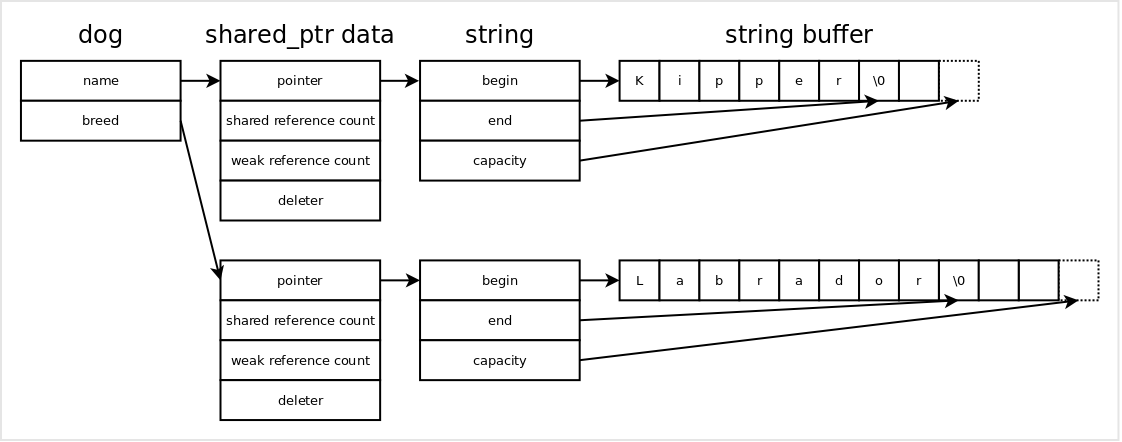Mircea Baja # On coding style --- # On general writing style "The Elements of Style" by William Strunk and E. B. White: <blockquote> Form the possessive singular of nouns by adding 's. </blockquote> "Clear and simple as the truth: writing classic prose" by Francis-Noël Thomas and Mark Turner: <blockquote> A style is defined by it's conceptual stand on truth, presentation, writer, reader, thought, language, and their relationship </blockquote> --- # Sample problem --- background-image: url(/assets/2018-01-29-reflection/labrador.jpg) --- # Data ```json { "name": "Kipper", "breed": "Labrador" } ``` --- # OOP style ```cpp class dog { private: std::shared_ptr<std::string> name_; std::shared_ptr<std::string> breed_; public: std::shared_ptr<std::string> get_name() { return name_; } void set_name(std::shared_ptr<std::string> value) { name_ = value; } std::shared_ptr<std::string> get_breed() { return breed_; } void set_breed(std::shared_ptr<std::string> value) { breed_ = value; } void init(const Json & doc) { name_ = doc.get_string("name"); breed_ = doc.get_string("breed"); } }; ``` --- # Consequences  --- # Lambda style ```cpp void dog_from_json( std::function<std::string(const char * key)> property, std::function<const std::string & name, const std::string & breed> callback) { callback(property("name"), property("breed")); } [&doc]() { std::string name; std::string breed; dog_from_json([&doc](const char * key) { return doc.get_string(key); }, [&] (const std::string & name_, const std::string & breed_) { name = name_; breed = breed_; }); // use name and breed here ... } (); ``` --- # Classic style ```cpp struct dog { std::string name; std::string breed; }; dog dog_from_json(const Json & doc) { return { doc.get_string("name"), doc.get_string("breed") }; } ``` --- # Consequences  --- # Performance style ```cpp void dog_from_json(char * json_buffer, char ** name, char ** breed) { // gets a non-const buffer of characters and will point name and breed // to values in the buffer } ``` --- # On styles There are a multitude of coding styles (but some are better than others) They are defined by - attitudes to truth - representation - abstraction usage - generality - relation between the writer and reader. --- # Classic style - assumes there is one true, identifiable representation - that the right representation needs to be chosen (e.g. objects vs. functions) - uses abstractions as necessary - aims for a certain generality and elegance - simplicity hides the effort to achieve it --- # Superficial elements Indentation and tab wars. Notice the similarity between the first rule in "The Elements of Style": <blockquote> Form the possessive singular of nouns by adding 's. [...] Exceptions are the possessive of ancient proper names ending in -es and is, [...] </blockquote> and the first rule in the "Google C++ Style Guide": <blockquote> In general, every .cc file should have an associated .h file. There are some common exceptions, such as unittests and small .cc files containing just a main() function. </blockquote> --- # References Francis-Noël Thomas and Mark Turner:<br/> Clear and simple as the truth: writing classic prose<br/> 2nd edition William Strunk and E. B. White:<br/> The Elements of Style Labrador picture<br/> https://pixabay.com/en/animal-dog-puppy-pet-photography-2184791/ Google C++ Style Guide<br/> https://google.github.io/styleguide/cppguide.html --- # Questions? https://bajamircea.github.io/presentations/2018-07-06-on-coding-style.html